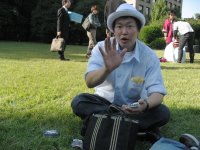
The rest of the week was relatively uneventful, save for a chance encounter with Danny, the Korean magician. Apparently he was in Okuma garden looking for people to practice his magic on, but unfortunately for him, I was with Derek, who had actually taken magic classes, and was able to spot all the tricks. Eventually, it turned into an English lesson for Danny, who had only been doing magic for about a year. I wished him luck as I escaped to the gym. That excitement aside, let's move on to the next art class.
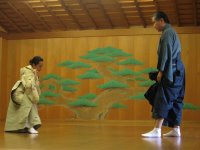
This time, we would be going to adjacent half of the school dedicated to the performing arts. We first sat in on a Noh lesson. A single female student in a heavy kimono was sonorously chanting and moving all about the raised platform as the teacher in hakama stood to the side, chanting the narration and occasionally switching to his normal voice to give direction to the student. The movements were very exacting, it must take a lot of discipline to memorize such a long and complicated performance. We moved on from there, splitting into two separate groups. The lessons were usually conducted in very small rooms, so our whole class wouldn't fit if we all tried to go. I went with the group to see the Shakuhachi lesson (bamboo flute). We saw a one-on-one lesson with an advanced student simultaneously playing with the teacher. The lyrical aspirations of the flute tell a very harmonious story in the hands of a master. From there, we went to see the beginning lesson, comprised of students who were majoring in other instruments. I think we came to their first lesson, because they were just learning how to hold the flute.
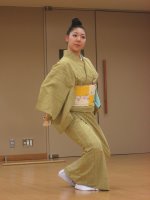
From there, we went to see a traditional folk dancing lesson. The master greeted us and ushered us to the side of the room, and several of the kimono-clad students performed a number of dances for us. Their movements were very deliberate, but had a sense of delicacy and flowingness to them that was absent in the stout Noh performance we witnessed earlier. After about 15 minutes, we arose and took our leave once again, thanking the teacher for letting us watch.
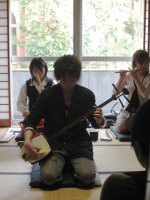
We then headed to another part of the building, where there was a Japanese orchestra of Shamisen, flutes, drums and other instruments I have yet to hear of. The students, who were all very skilled but half of whom were still in high school, were practicing festival music for an upcoming event in Ueno. I was very impressed with the way they all played together without a conductor; the various instruments blended together until we heard a single sound from which the individual voices could no longer be extracted. The shamisen players were especially fun to watch, because they tended to be the most animated of the group.
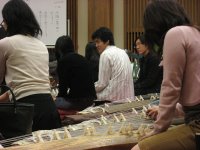
Finally, we went to sit in on a giant beginning Koto class. It seemed that people from all of the classes we had visited had come to help out the students. We saw the kimono-clad folk dancers come in to help the students set up their instruments. We were there for about 20 minutes, just watching them set up their strings as more and more students crowded the floor. I was exhausted and started to actually nod off. Finally, our teacher said that it would still be a while before the class would be able to start, so we could all go home at that point. We made our way to the exit, and I headed back home to take a much-needed nap. Halfway home, I realized that I must had dropped the small bag I had used for my camera somewhere at the school. I still had my camera, but the bag was missing. Not willing to go back to look for it (as it was just a pouch that came free with my wireless mouse), I gave it up for lost and went back to sleep.
 The rest of the week was relatively uneventful, save for a chance encounter with Danny, the Korean magician. Apparently he was in Okuma garden looking for people to practice his magic on, but unfortunately for him, I was with Derek, who had actually taken magic classes, and was able to spot all the tricks. Eventually, it turned into an English lesson for Danny, who had only been doing magic for about a year. I wished him luck as I escaped to the gym. That excitement aside, let's move on to the next art class.
The rest of the week was relatively uneventful, save for a chance encounter with Danny, the Korean magician. Apparently he was in Okuma garden looking for people to practice his magic on, but unfortunately for him, I was with Derek, who had actually taken magic classes, and was able to spot all the tricks. Eventually, it turned into an English lesson for Danny, who had only been doing magic for about a year. I wished him luck as I escaped to the gym. That excitement aside, let's move on to the next art class. This time, we would be going to adjacent half of the school dedicated to the performing arts. We first sat in on a Noh lesson. A single female student in a heavy kimono was sonorously chanting and moving all about the raised platform as the teacher in hakama stood to the side, chanting the narration and occasionally switching to his normal voice to give direction to the student. The movements were very exacting, it must take a lot of discipline to memorize such a long and complicated performance. We moved on from there, splitting into two separate groups. The lessons were usually conducted in very small rooms, so our whole class wouldn't fit if we all tried to go. I went with the group to see the Shakuhachi lesson (bamboo flute). We saw a one-on-one lesson with an advanced student simultaneously playing with the teacher. The lyrical aspirations of the flute tell a very harmonious story in the hands of a master. From there, we went to see the beginning lesson, comprised of students who were majoring in other instruments. I think we came to their first lesson, because they were just learning how to hold the flute.
This time, we would be going to adjacent half of the school dedicated to the performing arts. We first sat in on a Noh lesson. A single female student in a heavy kimono was sonorously chanting and moving all about the raised platform as the teacher in hakama stood to the side, chanting the narration and occasionally switching to his normal voice to give direction to the student. The movements were very exacting, it must take a lot of discipline to memorize such a long and complicated performance. We moved on from there, splitting into two separate groups. The lessons were usually conducted in very small rooms, so our whole class wouldn't fit if we all tried to go. I went with the group to see the Shakuhachi lesson (bamboo flute). We saw a one-on-one lesson with an advanced student simultaneously playing with the teacher. The lyrical aspirations of the flute tell a very harmonious story in the hands of a master. From there, we went to see the beginning lesson, comprised of students who were majoring in other instruments. I think we came to their first lesson, because they were just learning how to hold the flute. From there, we went to see a traditional folk dancing lesson. The master greeted us and ushered us to the side of the room, and several of the kimono-clad students performed a number of dances for us. Their movements were very deliberate, but had a sense of delicacy and flowingness to them that was absent in the stout Noh performance we witnessed earlier. After about 15 minutes, we arose and took our leave once again, thanking the teacher for letting us watch.
From there, we went to see a traditional folk dancing lesson. The master greeted us and ushered us to the side of the room, and several of the kimono-clad students performed a number of dances for us. Their movements were very deliberate, but had a sense of delicacy and flowingness to them that was absent in the stout Noh performance we witnessed earlier. After about 15 minutes, we arose and took our leave once again, thanking the teacher for letting us watch. We then headed to another part of the building, where there was a Japanese orchestra of Shamisen, flutes, drums and other instruments I have yet to hear of. The students, who were all very skilled but half of whom were still in high school, were practicing festival music for an upcoming event in Ueno. I was very impressed with the way they all played together without a conductor; the various instruments blended together until we heard a single sound from which the individual voices could no longer be extracted. The shamisen players were especially fun to watch, because they tended to be the most animated of the group.
We then headed to another part of the building, where there was a Japanese orchestra of Shamisen, flutes, drums and other instruments I have yet to hear of. The students, who were all very skilled but half of whom were still in high school, were practicing festival music for an upcoming event in Ueno. I was very impressed with the way they all played together without a conductor; the various instruments blended together until we heard a single sound from which the individual voices could no longer be extracted. The shamisen players were especially fun to watch, because they tended to be the most animated of the group. Finally, we went to sit in on a giant beginning Koto class. It seemed that people from all of the classes we had visited had come to help out the students. We saw the kimono-clad folk dancers come in to help the students set up their instruments. We were there for about 20 minutes, just watching them set up their strings as more and more students crowded the floor. I was exhausted and started to actually nod off. Finally, our teacher said that it would still be a while before the class would be able to start, so we could all go home at that point. We made our way to the exit, and I headed back home to take a much-needed nap. Halfway home, I realized that I must had dropped the small bag I had used for my camera somewhere at the school. I still had my camera, but the bag was missing. Not willing to go back to look for it (as it was just a pouch that came free with my wireless mouse), I gave it up for lost and went back to sleep.
Finally, we went to sit in on a giant beginning Koto class. It seemed that people from all of the classes we had visited had come to help out the students. We saw the kimono-clad folk dancers come in to help the students set up their instruments. We were there for about 20 minutes, just watching them set up their strings as more and more students crowded the floor. I was exhausted and started to actually nod off. Finally, our teacher said that it would still be a while before the class would be able to start, so we could all go home at that point. We made our way to the exit, and I headed back home to take a much-needed nap. Halfway home, I realized that I must had dropped the small bag I had used for my camera somewhere at the school. I still had my camera, but the bag was missing. Not willing to go back to look for it (as it was just a pouch that came free with my wireless mouse), I gave it up for lost and went back to sleep.
1 comment:
Ahh, I remember that trip to there. Unfortunately, during the time I went the Noh group was taking a day off or something. I saw Noh many months later in Tohoku during some festival instead in Hiraizumi.
The National Art Museum in Ueno, as well as the Tokyo Edo Museum are two of the top ones you will go to. The Mingeikan is also a bit interesting at the end of the semester, as they have a lot of art that does not normally show up at museums. I did some work for that museum which I still can't talk about because the documents I saw were being put together for a book. If you get a chance to volunteer for there, go for it. At least once. Dym would have flipped if he knew the documents I got to see, and in English too.
Oh, and don't forget to go to the Yasukuni Musuem around Kudanshita. You have to go there. The extreme nationalist history displayed is scary as well as entertaining.
Post a Comment